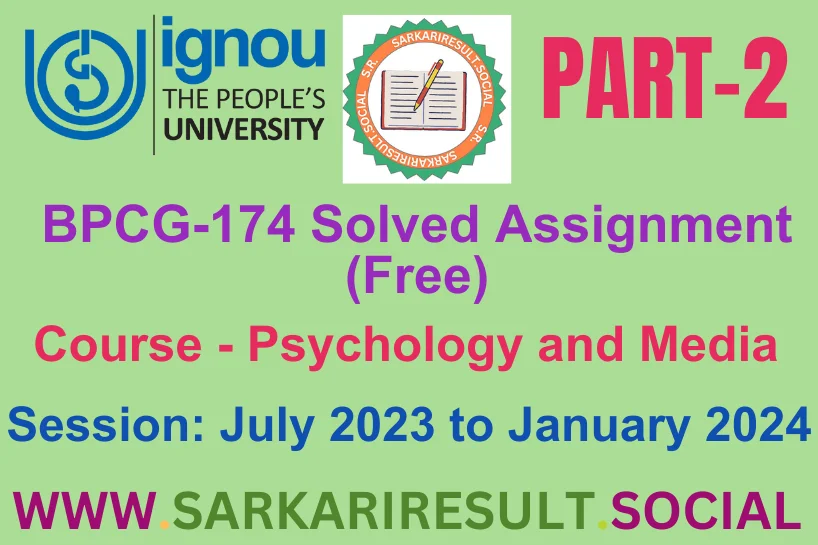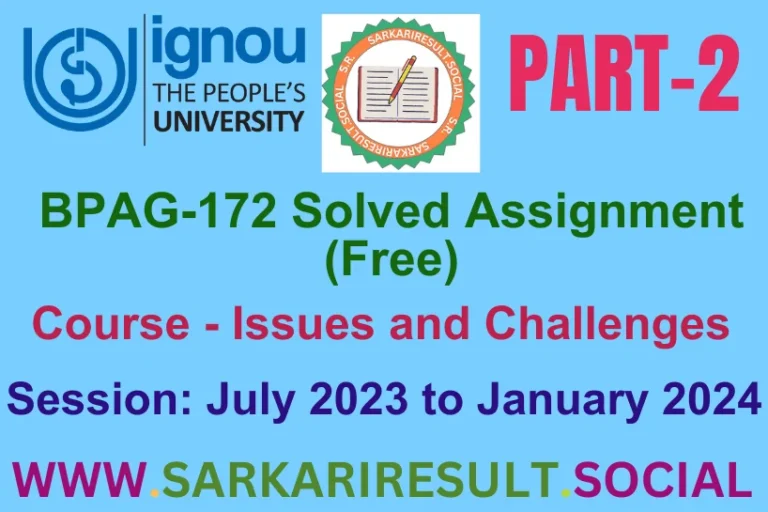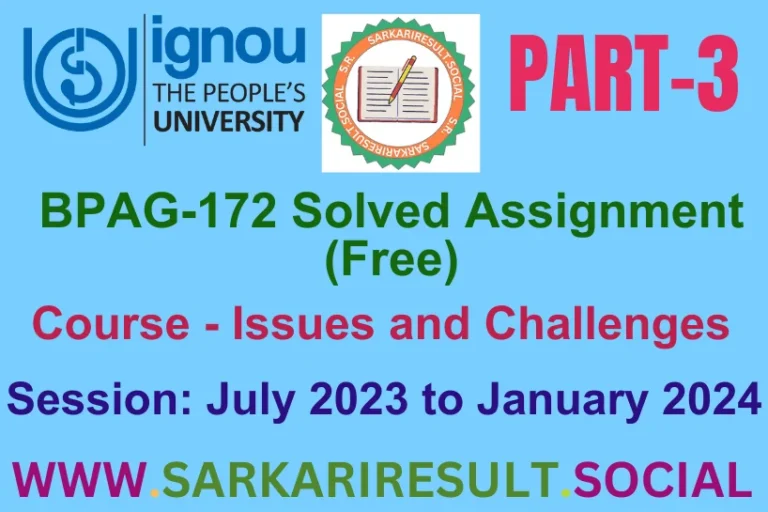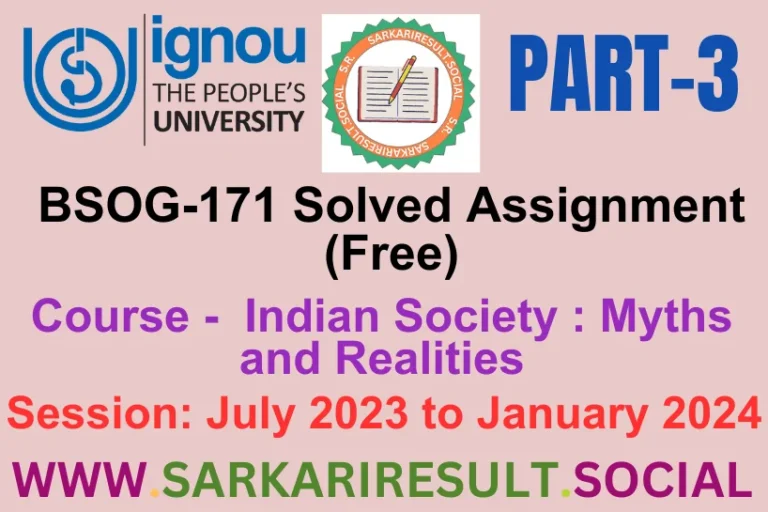BPCG 174 SOLVED IGNOU ASSIGNMENT FREE PART 2

Welcome to the BPCG 174 SOLVED IGNOU ASSIGNMENT FREE PART 2 TMA. Assignment Two presents three insightful questions, each designed for concise responses of approximately 250 words. Delve into the influence of media on stereotype formation, unravel the complexities of the politics of media representation, and explore the concept of parasocial relationships by defining it and explaining its key characteristics. Our IGNOU Solved Assignments 2024 for this section serve as your creative guide.

Answer the following questions in about 250 words each.
Q.3 Discuss the role of media in formation of stereotypes.
Ans. Media plays a significant role in the formation and perpetuation of stereotypes, contributing to the shaping of societal attitudes and expectations. Stereotypes are simplified and generalized perceptions about individuals or groups based on characteristics such as gender, race, ethnicity, or socio-economic status. The role of media in this process is multifaceted:
1. Reinforcement of Existing Stereotypes:
– Media often reinforces existing stereotypes by consistently portraying certain groups in specific roles or with particular traits. For example, women may be consistently depicted as caregivers or individuals from certain ethnic backgrounds as criminals, reinforcing gender and racial stereotypes.
2. Selective Representation:
– Media can selectively represent individuals or groups, emphasizing certain aspects while neglecting others. This selective portrayal can contribute to the creation and reinforcement of narrow and biased stereotypes.
3. Underrepresentation and Tokenism:
– Underrepresentation of certain groups or their tokenistic inclusion can perpetuate stereotypes. When minority groups are portrayed in limited and often exaggerated ways, it can lead to the reinforcement of pre-existing biases.
4. Typecasting in Entertainment:
– In the entertainment industry, individuals from specific backgrounds may be typecast into certain roles, limiting the diversity of characters. This typecasting reinforces cultural or ethnic stereotypes, hindering authentic and varied representation.
5. Media Framing and Language:
– The way media frames stories and the language used can contribute to the formation of stereotypes. Negative framing or biased language can influence public perceptions, reinforcing stereotypes about particular groups.
6. Social Media Influence:
– Social media platforms can amplify stereotypes through the rapid dissemination of information. Memes, images, and content shared on social media contribute to the spread and reinforcement of stereotypes.
7. Advertising and Beauty Standards:
– Advertising often perpetuates stereotypes, particularly in terms of beauty standards. The portrayal of idealized body images, lifestyles, or beauty norms can contribute to stereotypical expectations and judgments.
8. Impact on Implicit Bias:
– Constant exposure to stereotypical portrayals in media can contribute to the development of implicit biases—unconscious associations and attitudes. These biases can influence how individuals perceive and interact with others.
Addressing the role of media in stereotype formation requires media literacy education, diverse representation in media, and responsible content creation. Promoting critical thinking about media messages, encouraging authentic and diverse storytelling, and fostering awareness about the impact of stereotypes are crucial steps in mitigating the negative effects of media on societal perceptions.
Q.4 Explain the main issues in the politics of media representation.
Ans. The politics of media representation encompasses a complex terrain where power dynamics, biases, and socio-cultural factors play a significant role in shaping how different individuals and groups are portrayed. Here are the main issues in the politics of media representation:
1. Underrepresentation:
– Certain groups, particularly marginalized communities such as racial and ethnic minorities, women, and LGBTQ+ individuals, are often underrepresented in media. This lack of diverse representation can perpetuate stereotypes and reinforce existing power imbalances.
2. Stereotyping and Misrepresentation:
– Media frequently relies on stereotypes and can perpetuate harmful misconceptions about certain groups. Stereotypes contribute to simplified and often inaccurate portrayals that may influence public perceptions and attitudes.
3. Tokenism:
– Tokenism involves including one or a few individuals from a marginalized group to create an appearance of diversity. However, this superficial representation may not address deeper issues of systemic exclusion and can contribute to tokenistic stereotypes.
4. Cultural Appropriation:
– Cultural appropriation in media involves the adoption of elements from a culture without understanding or respecting its significance. This can lead to misrepresentation and exploitation, reinforcing cultural stereotypes and undermining the authenticity of diverse cultures.
5. Whitewashing:
– Whitewashing occurs when white actors are cast in roles intended for characters of different racial or ethnic backgrounds. This practice erases authentic representations and perpetuates racial inequality in the film and television industry.
6. Body Image and Beauty Standards:
– Media often promotes unrealistic beauty standards, contributing to body dissatisfaction and self-esteem issues, particularly among women. Limited representations of diverse body types can exclude and marginalize individuals who do not conform to narrow beauty norms.
7. Ageism:
– Media representations often perpetuate ageist attitudes by marginalizing or stereotyping older individuals. This can contribute to negative perceptions and discrimination based on age.
8. Political Bias:
– Media outlets can be influenced by political biases that shape how events, issues, and individuals are portrayed. This bias can impact public opinion and contribute to polarization within society.
Addressing these issues requires a commitment to diversity, equity, and inclusion in media production, more inclusive hiring practices, and fostering media literacy. By challenging stereotypes, providing authentic representation, and promoting a broader understanding of diverse experiences, the politics of media representation can become a force for positive social change.
Q.5 Define parasocial relationship. Explain the characteristics of parasocial relationship.
Ans. A parasocial relationship refers to a one-sided, perceived connection that an individual forms with a media personality or character. This connection is characterized by a sense of intimacy and familiarity, even though it is entirely one-sided, with the media figure unaware of the individual’s existence. Parasocial relationships commonly develop between viewers or fans and celebrities, television characters, social media influencers, or other public figures.
Characteristics of Parasocial Relationships:
1. Asymmetry:
– Parasocial relationships are inherently imbalanced. The individual invests emotionally, cognitively, and sometimes financially in the relationship, while the media figure remains unaware of the specific individual. This one-sided nature is a fundamental characteristic.
2. Perceived Intimacy:
– Individuals in parasocial relationships feel a sense of emotional closeness and intimacy with the media figure. This perception often arises from the personal nature of the content presented, such as a celebrity sharing aspects of their life on social media or through interviews.
3. Illusion of Reciprocity:
– Despite the lack of real interaction, individuals may feel a sense of reciprocity in the relationship. They might believe that the media figure understands them or values their support, even though the communication is entirely one-way.
4. Emotional Investment:
– Individuals in parasocial relationships invest time and emotions in following the media figure’s life, work, or content. This emotional investment can lead to a sense of loyalty and attachment, akin to how one might feel toward a friend.
5. Fulfillment of Social Needs:
– Parasocial relationships can fulfill social needs for companionship and connection, especially for those who may experience loneliness or social isolation. The media figure becomes a symbolic companion.
6. Impact on Behavior:
– Parasocial relationships can influence individuals’ behavior, preferences, and consumption patterns. Fans may be more likely to support a celebrity’s projects, emulate their lifestyle, or defend them in online discussions.
7. Media Consumption Patterns:
– Parasocial relationships often dictate media consumption patterns. Individuals may actively seek out and consume content featuring the media figure, creating a cyclical relationship where increased exposure strengthens the parasocial bond.
8. Transient Nature:
– Parasocial relationships can be transient, evolving or diminishing over time. Changes in the media figure’s image or actions can significantly impact the strength and nature of the parasocial connection.
Understanding parasocial relationships is crucial in media studies, psychology, and sociology as it sheds light on the ways in which media figures influence individuals’ emotions, perceptions, and behaviors, even in the absence of genuine interpersonal interaction.
Also See This: BPCG 174 SOLVED IGNOU ASSIGNMENT FREE PART 3







